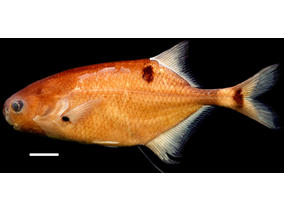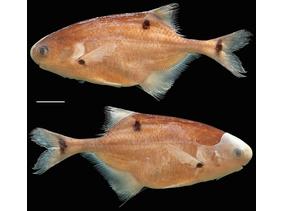You are here
Mormyridae
Petrocephalus arnegardi Lavoué & Sullivan, 2014
Nomenclature
-
Subfamily: PetrocephalinaeGenus: Petrocephalus
SUMMARY
From Lavoué and Sullivan (2014):
Body ovoid, longer than high (2.3 ≤ SL/H ≤ 2.8, average = 2.6, holotype = 2.5) and laterally compressed. Head length between 3.4 and 4.0 times in standard length (average = 3.6, holotype = 3.4). Snout short (6.5 ≤ HL/SNL ≤ 9.3, average = 7.5, holotype = 8.3) and round. Eye large (3.5 ≤ HL/ED ≤ 4.4, average = 4.0, holotype = 4.1). Mouth small (4.1 ≤ HL/MW ≤ 5.0, average = 4.6, holotype = 4.5), subterminal, opening under the anterior half of the eye. Teeth small and bicuspid, 8 to 16 (median = 10) in a single row in the upper jaw, 20 to 24 (median = 21) in the lower jaw. Dorsal and anal fins originate in the posterior half of the body (1.4 ≤ SL/PDD ≤ 1.6 and 1.6 ≤ SL/PAD ≤ 1.7, respectively). Pre-dorsal distance slightly greater than the pre- anal distance (PDD/PAD = 1.1). Dorsal fin with 20–22 branched rays (median = 21). Anal fin with 31–34 branched rays (median = 32, holotype = 32). Scales cover the body, except for the head. Lateral line visible and complete with 34 to 38 pored scales along its length. Ten to 13 scales (median = 11), between the anterior base of the anal fin and the lateral line. Caudal peduncle thin (1.8 ≤ CPL/CPD ≤ 2.5, average = 2.2, holotype = 2.2). Twelve scales around the caudal peduncle. Skin on head thick. The three rosettes of Knollenorgans, Augenrosette, Nackenrosette and Kehlrosette, are present on the head.




